Since the 2019 model year represented big redesigns for both the Ram 1500 and the GM twins, I’ve spent an inordinate amount of time debating which of the two I prefer. The Ram wins me over in the looks department, dare I say the interior is more refined, and it generally rides better. The Chevrolet Silverado (reviewed here) and its twin, the GMC Sierra feel more truck-like, offer more power, and include some very practical features that make them a little more practical for real-work. The Ram now gets a new regenerative braking hybrid system, so we jumped into a 2019 Ram 1500 Laramie Long Horn with eTorque technology to see if it has what it takes to edge out the competition.
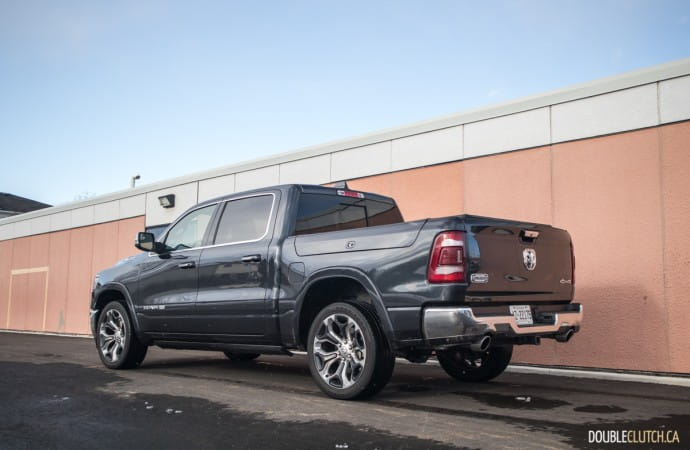
The eTorque system is a regenerative braking technology that’s not uncommon anymore, but typically only found in cars ranging from mild hybrids. Ram is the first to go mainstream with such a system in a full-size truck. The eTorque system replaces the conventional alternator, which is spun via an accessory belt off the engine, with a 48-volt motor/generator that captures braking energy and stores it for use boosting the engine at low speeds.
Beyond the moderately sized generator mounted at the top of the 5.7-liter Hemi and a 430 watt-hour, air-cooled, lithium-ion battery pack mounted on the rear wall of the cab, there isn’t much in the way of unique components on eTorque models, comforting for buyers like myself who tend to favor DIY maintenance as a vehicle ages. The way the system works is that whenever the truck is coasting or slowing to a stop, the generator is spinning off the engine and creating power and charging the battery pack. As soon as you begin to accelerate, the generator transitions to act like a motor and gives the main engine a boost of power directly to the crankshaft.
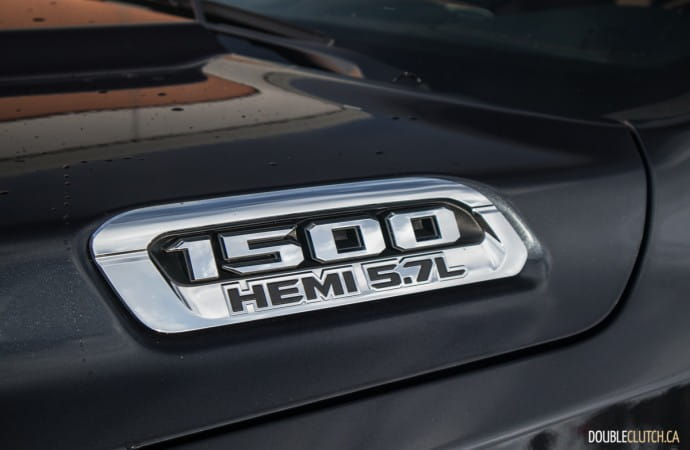
Energy from the battery pack is used to power accessories like the engine cooling fans or the vehicle’s smooth stop/start system. This means that the main engine doesn’t need to power these accessories, so more of its power can be put to the wheels. The system also provides an additional 130 lb-ft. of torque for acceleration below 2,000RPM when equipped on the HEMI V8. This number drops to 90 lb-ft. when mated to the 3.6-liter Pentastar V6.
This sort of technology may seem a bit foreign on a mean-looking HEMI powered pickup truck, especially our fully decked out Long Horn tester with its acres of soft, rich and gorgeously stitched leather, raw wood accents and flashy 22” rims, but truthfully this is where trucks will need to continue to go in order to meet tightening fuel economy requirements, and continue to deliver buyers with more power and efficiency without compromise. This is the type of technology that works in the background, and thankfully the designers at Ram recognize that and have refrained from tarting up this gorgeous truck with any sort of badging, logos or otherwise.
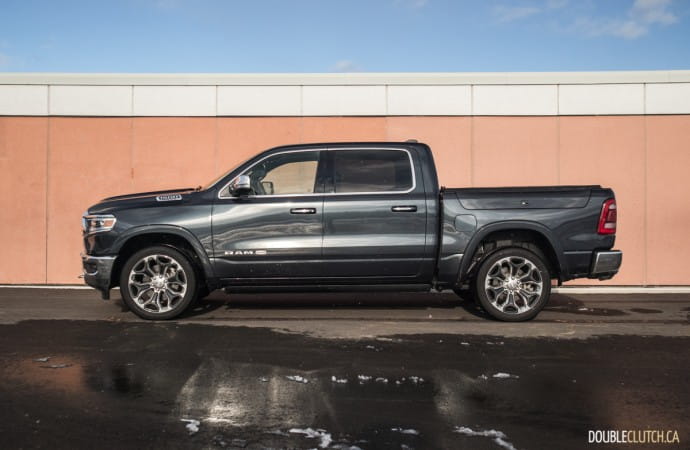
From behind the wheel the Ram with eTorque doesn’t feel significantly different than a regular HEMI Ram, save for a slight bit more gumption off the line. That’s a good thing because the Ram 1500, with or without eTorque, is the most refined full-sized pickup truck today. The 5.7-liter HEMI V8 makes 395 horsepower and 410 lb-ft. of torque at 3,950RPM (plus the additional 130 lb-ft. from the eTorque system). It’s paired to an eight-speed automatic and moves the hefty truck around with authority, while sounding like a good truck should and delivering a very smooth refined driving experience. Beyond that, the Ram rides phenomenally thanks to the optional air-ride suspension which pairs perfectly with the vault-like cabin that’s more comparable to a Mercedes S-Class (reviewed here) than a work truck.
I was hoping that the eTorque system was going to make a big dent in the one weak point I’ve been able to find with the current Ram, fuel economy. While the claims seem strong with a published government rating of 12.9L/100km in mixed driving, I struggled to best the 14.5L/100km I had scored in the non-eTorque Ram in my standard commute. While the system likely can offer considerable fuel savings in the right conditions, our usage obviously wasn’t conducive to that.
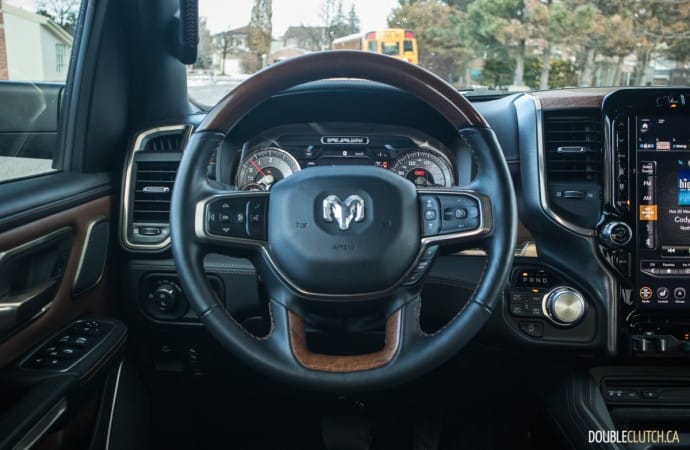
Whether you opt for eTorque or not, it’s really hard not to fall for the Ram 1500, particularly once you’ve spent some time inside of it. The interior in the Long Horn is amazing to put it bluntly – it’s finished to luxury car levels of quality and materials; soft stitched leather everywhere on the dashboard, door panels, and on the heated and cooled seats. The leather is complemented by south western cowboy-styled motifs, raw wood trim, and impressive little touches like saddle style buckles on the rear seat pockets.
A 12-inch touchscreen dominates the dashboard running the latest UConnect infotainment system, and ergonomically the Ram remains a favorite. Its controls all fall to hand well and I’ve learned to appreciate the space-saving rotary dial gear selector. My one gripe here remains that fact that the heated seat and steering wheel controls are buried in a menu in the touchscreen, patience for that runs thin very quickly on cold Canadian mornings.
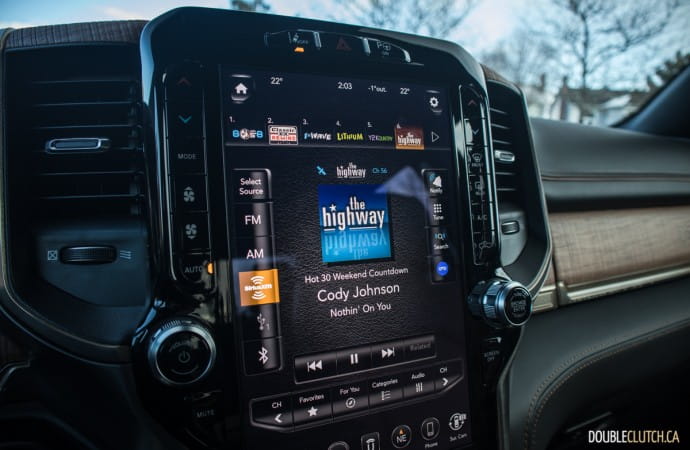
Of course, as a truck meant for all of life’s duties, the interior has been built with plenty of handy storage and gadgets. There are literally power outlets everywhere, including a 110V household plug, standard 12V outlets, USB, and even USB-C. Storage is plentiful with massive door pockets, dual gloveboxes, hidden floor compartments and a centre console large enough to an entire laptop.
Obviously, being a top of the line Laramie Long Horn, our tester came equipped with a glutton of luxurious features such as a massive dual-pane panoramic glass sunroof, heated and cooled seats all around, heated steering wheel, 19-speaker 900W Harman-Kardon stereo, parallel park assist, adaptive cruise control, LED lighting inside and out, four-corner air suspension, birds-eye camera views, and much more. If it’s available, this truck has it, and with an $86,600 price tag, this is to be expected.

When it comes to getting work done, the latest Ram’s new lighter and longer platform means towing and payload ratings have increased to a maximum of 12,750 and 2,300 pounds, respectively, when properly equipped. Naturally, these numbers vary depending on the truck’s configuration, but the eTorque system is required to unlock the max tow rating. Our particular tester with its crew cab, short (5.5’) bed and Ram Box storage bins is more of a luxurious family hauler than a work truck. Perfect for cottaging and summer road trips, the short and narrowed bed isn’t likely to score points on most job sites, though it did handle thirty 2x4s effortlessly during our test. Fortunately, if that’s not your thing there are literally hundreds of ways to equip a Ram specific to your needs.
Speaking of which, the Ram’s versatility is reflected in its pricing, which starts as low as $32,845 for a basic V6 work truck, and into the mid 40’s for a decently equipped HEMI powered crew cab. If the eTorque system is of interest to you, it can be added to the HEMI for a modest $795, a very low cost of entry into the forefront of half-ton truck technology. If the Laramie Long Horn is what gets your gears turning you can get into a 4×4 Long Horn with the HEMI and eTorque for $63,435. It’s when you start adding options that the pricing does get a bit out of hand, but that’s true of all trucks now days.
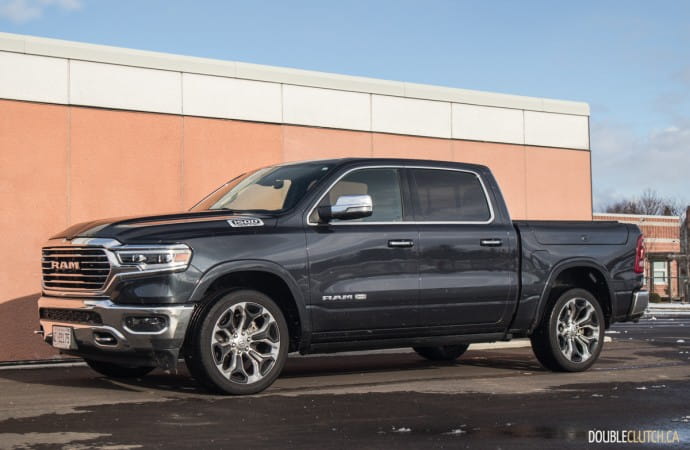
After spending some time with the 2020 Ram 1500 with eTorque, I’ve come away with a newfound appreciation for the engineering and technology that helps make the increasingly impressive vehicles we enjoy today possible. While this novel technology is leading the segment forward, it didn’t deliver many noteworthy benefits to my usage. What this time did confirm for me is that the Ram is absolutely the most livable truck for daily commuting and family duties, and for my purposes that’s perfect. If I were working the truck hard, with messy bulky loads, heavy off-roading or towing, then I might want something a little more traditionally truck-like and built, but the reality is that many truck buyers are just like me; commuters, parents and DIYers.
See Also:
2019 Chevrolet Silverado Trail Boss
2019 Ford F-150 Limited
2019 Ram 1500 Sport Crew Cab



































